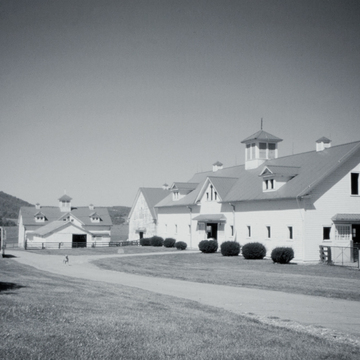You are here
Swift Level (Morlunda)
Surrounded by open fields and well-tended pastures, this handsome farm represents Greenbrier County at its agricultural best. The original L-shaped house, fronted by a monumental pedimented portico, was the centerpiece of Samuel N. McClung II's farm. Similar to porticoes on other area houses of the period, it has two columns that support only an architrave, not, as classical canons dictate, a full entablature. Inside, Conrod Burgess was particularly lavish in his joinery, embellishing the house with elegant mantels and a number of built-in cabinets, more akin to furniture than woodwork.
In 1934 Charleston industrialist Oscar Nelson (see CH24) purchased the property, renamed it Morlunda (Swedish for rolling ground) after his ancestral village, and commissioned architect Walter Martens to enlarge and modernize the house. Included in this work are long, one-story brick wings with Palladianarched porches at both ends of the main block and an extension of the rear ell that connects the house to the kitchen, originally a separate structure. The entire complex was painted white with a green standing-seam metal roof.
Unlike the McClungs, who used the farm primarily for horse breeding, Nelson was interested in cattle breeding. After purchasing additional farms to accumulate a total of 6,000 acres, he commissioned Martens to design a group of frame stables and barns north of the house. These buildings, painted in the same color scheme as the house and its dependencies, are among the most impressive farm buildings in the state. They are marked with elegant Palladian windows, cornice returns in the gable ends, and ample roofs punctuated with dormer windows and topped by louvered cupolas. Now known as Swift Level, the well-maintained property is still owned by Nelson descendants and is used as a bed-and-breakfast inn that offers equestrian activities.
Writing Credits
If SAH Archipedia has been useful to you, please consider supporting it.
SAH Archipedia tells the story of the United States through its buildings, landscapes, and cities. This freely available resource empowers the public with authoritative knowledge that deepens their understanding and appreciation of the built environment. But the Society of Architectural Historians, which created SAH Archipedia with University of Virginia Press, needs your support to maintain the high-caliber research, writing, photography, cartography, editing, design, and programming that make SAH Archipedia a trusted online resource available to all who value the history of place, heritage tourism, and learning.














